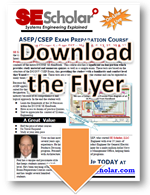Step 2
Once your application has been completed, it's time to prepare for the exam. SE Scholar has finished developing a new course based on INCOSE SE Handbook version 4 (SEHv4), which is the basis of the INCOSE Certification Exam. This course will help you contextualize the various Organizational, Project and Technical processes that are outlined in the Handbook.
With the aid of a comprehensive Process Flow diagram, we will walk you through all 31 Processes from the SE Handbook, from the Project Portfolio Process to the Disposal Process, in a logical and sequential manner, while covering the contents of the entire INCOSE SE Handbook.
Our on-line course includes videos of previous classes, study material, numerous quizzes, as well as a sample exam that are based on the structure of the INCOSE SEP Exam. This provides the student with a familiarity and comfort level they’ll need to pass the Exam. These tests are a valuable resource for the student and can be repeated as many times as the student desires.
Part of the Process Flow diagram that the students will use to understand the 31 SE Handbook Processes
Because the INCOSE Exam is used for the ASEP application as well, this course is also suited for those applying for their ASEP designation.
This course is one of the best in the industry because of its comprehensive and logical approach.
“This course takes a very complex topic and gives it structure and cohesion in order to impart knowledge as well as suggest best practices: two thumbs up !”
Course Outline
2. Introduction to Systems Engineering and the Life Cycle Model
- 1 Systems Engineering Handbook Scope
- 2 Systems Engineering Overview
- 3.3 Life Cycle Stages
- 3.2 Life Cycle Characteristics
- 7 Organizational Project-Enabling Processes
- 7.1 Life Cycle Model Management Process
3. Approaches to Systems Engineering
- 7.3 Portfolio Management Process
- 8 Tailoring process and Application of Systems Engineering
- 3.4 Life Cycle Approaches
- 3.4.1Iteration and Recursion
- 3.4.2Sequential Methods
- 3.4.3Incremental and Iterative Methods
- 9.2 Model-Based Systems Engineering
- 9.4 Object-Oriented Systems Engineering Method
- 9.8 Lean Systems Engineering
- 9.9 Agile Systems Engineering
- 10.13 Value Engineering
- 3.5 What Is Best for Your Organization, Project, or Team?
- 7.5 Quality Management Process
- 7.6 Knowledge Management Process
4. Project Planning From a SE Point Of View
- 7.2 Infrastructure Management Process
- 7.4 Human Resource Management Process
- 6.1 Acquisition Process
- 6.2 Supply Process
- 5.1 Project Planning Process
- 9.7 Integrated Product and Process Development
- 5.2 Project Assessment and Control Process
5. SE and Technical Management Processes
- 5.7 Measurement Process
- 5.3 Decision Management Process
- 5.4 Risk Management Process
- 5.5 Configuration Management Process
- 5.6 Information Management Process
- 5.8 Quality Assurance Process
6. Requirements
- 9.1 Modeling and Simulation
- 9.5 Prototyping
- 4.6 System Analysis Process
- 4.1 Business or Mission Analysis Process
- 4.2 Stakeholder Needs and Requirements Definition Process
- 4.3 System Requirements Definition Process
- 9.6 Interface Management
7. Design Considerations
- 9.3 Functions-Based Systems Engineering Method
- 10 Specialty Engineering Activities
- Affordability/Cost-Effectiveness ….
- Electromagnetic Compatibility
- Environmental Engineering Impact Analysis
- Interoperability Analysis
- Logistics Engineering
- Manufacturing and Producibility Analysis
- Mass Properties Engineering
- Reliability, Availability, and Maintainability
- Resilience Engineering
- System Safety Engineering
- System Security Engineering
- Training Needs Analyses
- Usability Analysis/HSI
8: Technical Processes
- 4.4 Architecture Definition Process
- 4.5 Design Definition Process
- 4.7 Implementation Process
- 4.8 Integration Process
- 4.9 Verification Process
- 4.1 Transition Process
- 4.11 Validation Process
- 4.12 Operation Process
- 4.13 Maintenance Process
- 4.14 Disposal Process
An online course consisting of 5 modules split into 2 sub-modules each. The videos are 2 ½ to 3 hours long, totaling over 25 hours of instructional videos, covering the entire INCOSE SE Handbook vs 5.0. Includes study guides, a comprehensive Process Flow diagram, practice quizzes, and a sample exam. Learn the material at your pace and in your time frame.
“Given that some sections of the [Handbook] are very dry, I appreciated Paul’s effort to keep it interesting and engaging. I would think it was difficult, but he managed to keep my attention entire time I attended the class! GREAT job Paul!”
“I just wanted to thank you again for your excellent instruction. .... achieving this certification is a huge accomplishment for me ... You’ve been an instrumental part of this accomplishment. ”







